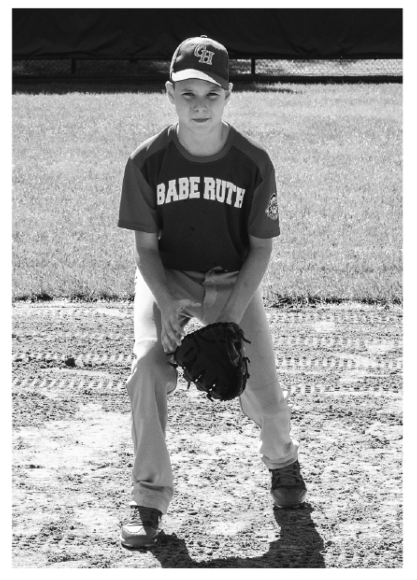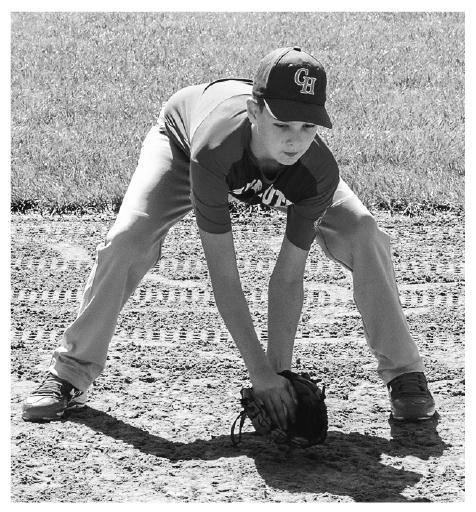Another type of catching that players must become skilled at is fielding ground balls. Because these are hit balls, they can sometimes be traveling much faster than a thrown ball, so it is even more crucial that good catching techniques are used by fielders; otherwise, the chances of an error are multiplied.
Ready Position
Before a ball is pitched, all fielders except the catcher and the pitcher should assume the ready position. In this stance, the player’s feet should be slightly wider than shoulder-width apart, with the knees bent and the weight over the balls of the feet (see figure 8.4). The player’s head should face the area near home plate. The hands should hang low between the legs, with the glove open wide. From this ready position, the player can get a good jump on the ball and move quickly in the direction it is hit.

FIGURE 8.4 Ready position for fielding ground balls.
Moving to the Ball
When a ground ball is hit in a player’s direction, he should move to the ball, keeping his glove-side shoulder to the right of the ball if he is right-handed (or to the left of the ball if he is left-handed). Leading with the glove, the player stays low and gets into a position where his body is in front of the ball. This can be best accomplished by taking a quick crossover step in the direction of the ball (if the ball is hit to the left or right of the fielder). The fielder must then get his body under control when the ball is about 15 feet away so that he can drop into fielding position. To do this, a right-handed fielder takes a step with his throwing-side foot toward the ball and lowers his body into fielding position; when the next step is taken with the glove-side foot, the feet are more than shoulder-width apart, and the ball is centered on the body. This technique is an important key to good fielding. Many fielders drop down too late and don’t have a chance to get into fielding position. Some never drop down at all and try to field the ball on the run.
Players should judge the speed and spin of the ball to determine where they need to move for good fielding position. With practice, players will learn to anticipate where the ball will bounce nearest to them and then move there to catch the ball. It’s best to stay low and catch the ball on a low hop, near the glove, rather than an in-between hop a few to several feet in front of the glove because in-between hops are much more difficult to gauge. Therefore, players need to learn to charge the ball—move toward it—to get that low hop. It’s much easier to field a ball when moving toward it than when rocking back on the heels and moving away from it.
Fielding the Ball
After moving to the ball, a player must get into the proper fielding position to field the ground ball. When the player moves his glove-side foot forward to center the body on the ball, the feet should be more than shoulder-width apart, with the toes pointed straight ahead. The throwing-side foot should be aligned slightly behind the glove-side foot so that the toes of the throwing-side foot are even with the instep of the other foot (see figure 8.5). The knees should be bent and the buttocks lowered to knee level. The player’s back should be almost parallel to the ground, and both arms should be outstretched in front of the body. The back of the fielder’s glove should be on the ground with the throwing hand either above it or alongside it. The fielder’s eyes should be focused on the ball. When the ball arrives, the player should watch it into the glove and then trap it with the throwing hand, as shown in figure 8.5. The player then cushions the ball toward his body with soft hands, bringing the hands to the belt area (this is called funneling the ball) as he moves into throwing position.

FIGURE 8.5 Fielding a ground ball.
Coaching Tip Players often have problems fielding ground balls because they try to bend for them with their back instead of their knees. This results in the player’s hands being too far under his body. When this happens, the player won’t be able to watch the ball all the way into the glove because his eyes will still be focused out in front of him and the ball will be underneath him. Remind your players that the ball is quicker than the eye.